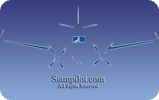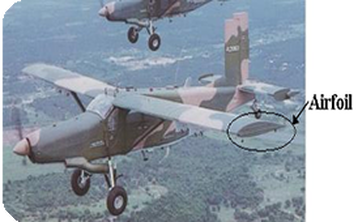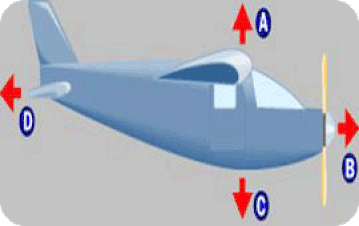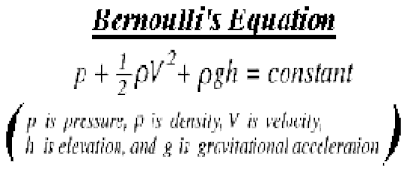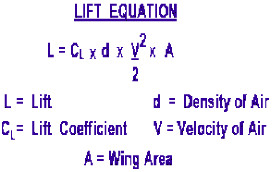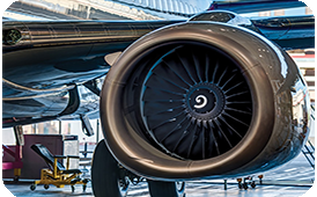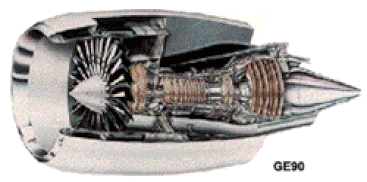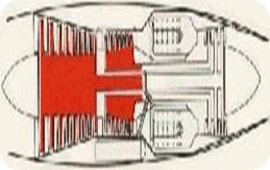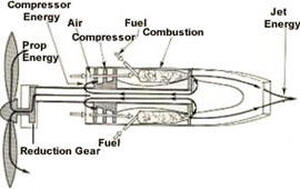faster over the wing. Faster air has less pressure than the slower higher pressure air under the wing. This pressure imbalance is lift. When the plane is at critical velocity (V1), lift equals weight. A few seconds later, lift is more than weight and the plane lifts off the ground.
There are THREE types of aircraft engine:
GAS-TURBINE TURBOFAN ENGINES
(Used by most modern aircraft)
(Used by most modern aircraft)
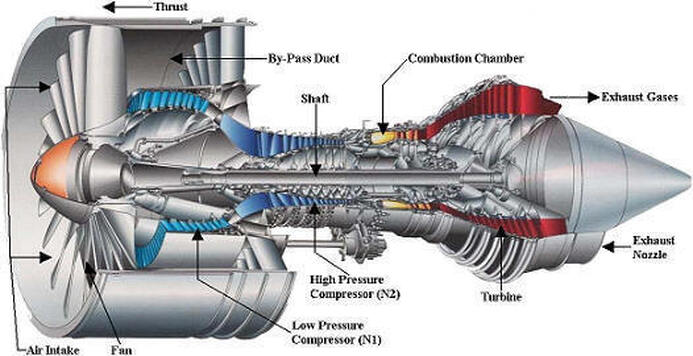
The fan rotates & sucks in air. About 80% of the air passes through the by-pass duct, cools the engine, & makes most of the thrust. The other 20% of the air is compressed, mixed with fuel, & ignited. The explosion passes through the turbine, making the turbine rotate. A shaft connects the turbine to the fans & compressors, so when the turbine rotates, the fans & compressors also rotate. The gases then pass through smaller & smaller areas, increasing the pressure. Finally, the gases pass out of the exhaust nozzle at very high speed, giving the engine thrust - Newton III (Action/Reaction)
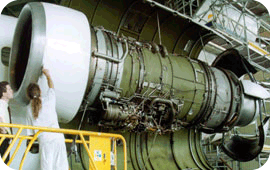
The advantages are:
1. The engine is good at high speed (more air goes directly into the compressors).
The disadvantages are:
1. The engine is hot and very loud (no by-pass duct).
2. The engine's fuel consumption is very high. With turbo-fan engines, more than 80% of the thrust comes from the fans.
3. The engine is not so good at low speed (less air goes directly into the compressors).
1. The engine is good at high speed (more air goes directly into the compressors).
The disadvantages are:
1. The engine is hot and very loud (no by-pass duct).
2. The engine's fuel consumption is very high. With turbo-fan engines, more than 80% of the thrust comes from the fans.
3. The engine is not so good at low speed (less air goes directly into the compressors).

The advantages are:
1. Thrust is generated by the propeller and by the exhaust nozzle, so the engine's fuel consumption is lower than turbo-jet engines. As a result, gas-turbine turbo-prop engines have a better range than even gas-turbine turbo-fan engines.
The disadvantages are:
1. The engine is quite hot and very loud (no by-pass duct).
2. Thrust from the exhaust nozzle is limited to only 10%. Too much thrust will break the propeller blades. This makes gas-turbine turbo-prop engines quite slow compared to gas-turbine turbo-fan and turbo-jet engines. However, there is an advantage. The 90% of thrust that is lost at the exhaust nozzle is forced downwards and out. This helps to increase lift. As a result, aircraft need less runway distance to take off.
1. Thrust is generated by the propeller and by the exhaust nozzle, so the engine's fuel consumption is lower than turbo-jet engines. As a result, gas-turbine turbo-prop engines have a better range than even gas-turbine turbo-fan engines.
The disadvantages are:
1. The engine is quite hot and very loud (no by-pass duct).
2. Thrust from the exhaust nozzle is limited to only 10%. Too much thrust will break the propeller blades. This makes gas-turbine turbo-prop engines quite slow compared to gas-turbine turbo-fan and turbo-jet engines. However, there is an advantage. The 90% of thrust that is lost at the exhaust nozzle is forced downwards and out. This helps to increase lift. As a result, aircraft need less runway distance to take off.
|
|
|
Useful Websites

